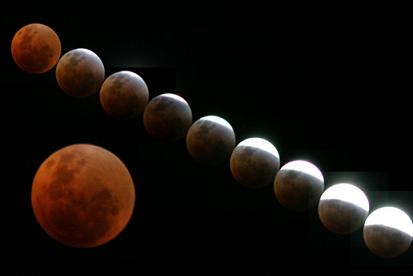The planets Mercury, Venus and Saturn will line up in a triangle pointing to the eclipsed moon * Around ten minutes past midnight the eclipse will reach its peak - 80% of the moon's diameter will be covered by the earth's shadow

A partial lunar eclipse, a phenomenon resulting from the passage of the edge of the Earth's shadow over the Moon, will be visible at midnight throughout Europe, Africa and Asia, as well as from Australia where dawn twilight will begin. The eclipse will begin at 22:35 and will end approximately three hours later, with around ten minutes past midnight the peak of the eclipse will be when approximately 80% of the moon's surface will be covered.
You should start watching the moon immediately at sunrise (and sunset - a combination that occurs of course only when the moon is full and not every evening), then the shadow will already begin to bite from the moon, until it ends as mentioned at 02:57. The Universe Today website recommends watching the moon with a telescope during the eclipse - both during the entry phase and during the exit phase. The craters take on new dimensions and fine details are illuminated as the shadow runs across the surface. And if you are lucky enough to watch the moon during the peak of the eclipse, you should also look at the stars that are visible near the moon, stars that normally cannot be seen.
One of the bodies that are usually hidden (at least for the next few days until the moon moves away from this point) is the planet Neptune which will be revealed for a little while. At the same time, immediately after sunset, you should look at the western horizon and look for the planets Mercury, Saturn and Venus, which will line up in a tight triangle with one of its vertices pointing towards the moon.

5 תגובות
It's a shame I missed it! Would you mind letting me know about the next eclipse?
Thanks Maxi
Indeed beautiful.
Note that a lunar eclipse is the only opportunity to see a partially illuminated moon from above.
In all the normal situations of a partial moon, the illuminated part is inclined downwards.
I hope you understand why.
The eclipse is wonderful, go see it!
Will it be possible to see it with the naked eye?
Thank you.